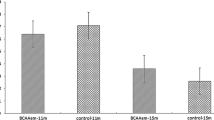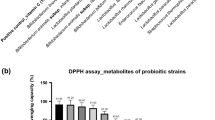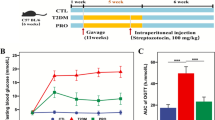Abstract
Both aging and diet play an important role in influencing the gut ecosystem. Using premature senescent rats induced by d-galactose and fed with high-fat diet, this study aims to investigate the effects of different potential probiotic strains on the dynamic changes of fecal microbiome and metabolites. In this study, male Sprague–Dawley rats were fed with high-fat diet and injected with d-galactose for 12 weeks to induce aging. The effect of Lactobacillus plantarum DR7, L. fermentum DR9, and L. reuteri 8513d administration on the fecal microbiota profile, short-chain fatty acids, and water-soluble compounds were analyzed. It was found that the administration of the selected strains altered the gut microbiota diversity and composition, even at the phylum level. The fecal short-chain fatty acid content was also higher in groups that were administered with the potential probiotic strains. Analysis of the fecal water-soluble metabolites revealed that administration of L. plantarum DR7 and L. reuteri 8513d led to higher fecal content of compounds related to amino acid metabolism such as tryptophan, leucine, tyrosine, cysteine, methionine, valine, and lysine; while administration of L. fermentum DR9 led to higher prevalence of compounds related to carbohydrate metabolism such as erythritol, xylitol, and arabitol. In conclusion, it was observed that different strains of lactobacilli can cause difference alteration in the gut microbiota and the metabolites, suggesting the urgency to explore the specific metabolic impact of specific strains on the host.












Similar content being viewed by others
References
Murphy EA, Velazquez KT, Herbert KM (2015) Influence of high-fat diet on gut microbiota: a driving force for chronic disease risk. Curr Opin Clin Nutr Metab Care 18(5):515–520. https://doi.org/10.1097/MCO.0000000000000209
Vaiserman AM, Koliada AK, Marotta F (2017) Gut microbiota: a player in aging and a target for anti-aging intervention. Aging Res Rev 35:36–45. https://doi.org/10.1016/j.arr.2017.01.001
Wu HJ, Wu E (2012) The role of gut microbiota in immune homeostasis and autoimmunity. Gut Microbes 3(1):4–14. https://doi.org/10.4161/gmic.19320
Qin J, Li R, Raes J, Arumugam M, Burgdorf KS, Manichanh C, Nielsen T, Pons N, Levenez F, Yamada T, Mende DR, Li J, Xu J, Li S, Li D, Cao J, Wang B, Liang H, Zheng H, Xie Y, Tap J, Lepage P, Bertalan M, Batto JM, Hansen T, Le Paslier D, Linneberg A, Nielsen HB, Pelletier E, Renault P, Sicheritz-Ponten T, Turner K, Zhu H, Yu C, Li S, Jian M, Zhou Y, Li Y, Zhang X, Li S, Qin N, Yang H, Wang J, Brunak S, Dore J, Guarner F, Kristiansen K, Pedersen O, Parkhill J, Weissenbach J, Meta HITC, Bork P, Ehrlich SD, Wang J (2010) A human gut microbial gene catalogue established by metagenomic sequencing. Nature 464(7285):59–65. https://doi.org/10.1038/nature08821
Cani PD, Delzenne NM (2009) The role of the gut microbiota in energy metabolism and metabolic disease. Curr Pharm Des 15(13):1546–1558. https://doi.org/10.2174/138161209788168164
Yang JY, Kweon MN (2016) The gut microbiota: a key regulator of metabolic diseases. BMB Rep 49(10):536–541. https://doi.org/10.5483/BMBRep.2016.49.10.144
D’Amelio P, Sassi F (2018) Gut microbiota, immune system, and bone. Calcif Tissue Int 102(4):415–425. https://doi.org/10.1007/s00223-017-0331-y
Clapp M, Aurora N, Herrera L, Bhatia M, Wilen E, Wakefield S (2017) Gut microbiota’s effect on mental health: the gut-brain axis. Clin Pract 7(4):987. https://doi.org/10.4081/cp.2017.987
Boulange CL, Neves AL, Chilloux J, Nicholson JK, Dumas ME (2016) Impact of the gut microbiota on inflammation, obesity, and metabolic disease. Genome Med 8(1):42. https://doi.org/10.1186/s13073-016-0303-2
Sanders ME (2016) Probiotics and microbiota composition. BMC Med 14(1):82. https://doi.org/10.1186/s12916-016-0629-z
Lye HS, Kato T, Low WY, Taylor TD, Prakash T, Lew LC, Ohno H, Liong MT (2017) Lactobacillus fermentum FTDC 8312 combats hypercholesterolemia via alteration of gut microbiota. J Biotechnol 262:75–83. https://doi.org/10.1016/j.jbiotec.2017.09.007
Song X, Bao M, Li D, Li YM (1999) Advanced glycation in D-galactose-induced mouse aging model. Mech Ageing Dev 108(3):239–251. https://doi.org/10.1016/S0047-6374(99)00022-6
Tsugawa H, Bamba T, Shinohara M, Nishiumi S, Yoshida M, Fukusaki E (2011) Practical non-targeted gas chromatography/mass spectrometry-based metabolomics platform for metabolic phenotype analysis. J Biosci Bioeng 112(3):292–298. https://doi.org/10.1016/j.jbiosc.2011.05.001
Nakajima A, Kaga N, Nakanishi Y, Ohno H, Miyamoto J, Kimura I, Hori S, Sasaki T, Hiramatsu K, Okumura K, Miyake S, Habu S, Watanabe S (2017) Maternal high fiber diet during pregnancy and lactation influences regulatory T cell differentiation in offspring in mice. J Immunol 199(10):3516–3524. https://doi.org/10.4049/jimmunol.1700248
Kato T, Fukuda S, Fujiwara A, Suda W, Hattori M, Kikuchi J, Ohno H (2014) Multiple omics uncovers host-gut microbial mutualism during prebiotic fructooligosaccharide supplementation. DNA Res 21(5):469–480. https://doi.org/10.1093/dnares/dsu013
Miyoshi J, Chang EB (2017) The gut microbiota and inflammatory bowel diseases. Transl Res 179:38–48. https://doi.org/10.1016/j.trsl.2016.06.002
Rebolledo C, Cuevas A, Zambrano T, Acuna JJ, Jorquera MA, Saavedra K, Martinez C, Lanas F, Seron P, Salazar LA, Saavedra N (2017) Bacterial community profile of the gut microbiota differs between hypercholesterolemic subjects and controls. Biomed Res Int 2017:8127814. https://doi.org/10.1155/2017/8127814
Blandino G, Inturri R, Lazzara F, Di Rosa M, Malaguarnera L (2016) Impact of gut microbiota on diabetes mellitus. Diabetes Metab 42(5):303–315. https://doi.org/10.1016/j.diabet.2016.04.004
Parashar A, Udayabanu M (2017) Gut microbiota: implications in Parkinson’s disease. Parkinsonism Relat Disord 38:1–7. https://doi.org/10.1016/j.parkreldis.2017.02.002
Vogt NM, Kerby RL, Dill-McFarland KA, Harding SJ, Merluzzi AP, Johnson SC, Carlsson CM, Asthana S, Zetterberg H, Blennow K, Bendlin BB, Rey FE (2017) Gut microbiome alterations in Alzheimer’s disease. Sci Rep 7(1):13537. https://doi.org/10.1038/s41598-017-13,601-y
O’Toole PW, Jeffery IB (2015) Gut microbiota and aging. Science 350(6265):1214–1215. https://doi.org/10.1126/science.aac8469
Lew LC, Choi SB, Khoo BY, Sreenivasan S, Ong KL, Liong MT (2018) Lactobacillus plantarum DR7 reduces cholesterol via phosphorylation of AMPK that down-regulated the mRNA expression of HMG-CoA reductase. Food Sci Anim Resour 38(2):350–361. https://doi.org/10.5851/kosfa.2018.38.2.350
Odamaki T, Kato K, Sugahara H, Hashikura N, Takahashi S, Xiao JZ, Abe F, Osawa R (2016) Age-related changes in gut microbiota composition from newborn to centenarian: a cross-sectional study. BMC Microbiol 16:90. https://doi.org/10.1186/s12866-016-0708-5
Mariat D, Firmesse O, Levenez F, Guimaraes V, Sokol H, Dore J, Corthier G, Furet JP (2009) The Firmicutes/Bacteroidetes ratio of the human microbiota changes with age. BMC Microbiol 9:123. https://doi.org/10.1186/1471-2180-9-123
Cho SY, Kim J, Lee JH, Sim JH, Cho DH, Bae IH, Lee H, Seol MA, Shin HM, Kim TJ, Kim DY, Lee SH, Shin SS, Lm SH, Kim HR (2016) Modulation of gut microbiota and delayed immunosenescence as a result of syringaresinol consumption in middle-aged mice. Sci Rep 6:39026. https://doi.org/10.1038/srep39026
Berni Canani R, Sangwan N, Stefka AT, Nocerino R, Paparo L, Aitoro R, Calignano A, Khan AA, Gilbert JA, Nagler CR (2016) Lactobacillus rhamnosus GG-supplemented formula expands butyrate-producing bacterial strains in food allergic infants. ISME J 10(3):742–750. https://doi.org/10.1038/ismej.2015.151
Kwok LY, Guo Z, Zhang J, Wang L, Qiao J, Hou Q, Zheng Y, Zhang H (2015) The impact of oral consumption of Lactobacillus plantarum P-8 on faecal bacteria revealed by pyrosequencing. Benefic Microbes 6(4):405–413. https://doi.org/10.3920/BM2014.0063
Neyrinck AM, Pachikian B, Taminiau B, Daube G, Frederick R, Cani PD, Bindels LB, Delzenne NM (2016) Intestinal sucrase as a novel target contributing to the regulation of glycemia by prebiotics. PLoS One 11(8):e0160488. https://doi.org/10.1371/journal.pone.0160488
Wang L, Zhang J, Guo Z, Kwok L, Ma C, Zhang W, Lv Q, Huang W, Zhang H (2014) Effect of oral consumption of probiotic Lactobacillus plantarum P-8 on fecal microbiota, SIgA, SCFAs, and TBAs of adults of different ages. Nutrition 30(7–8):776–783 e771. https://doi.org/10.1016/j.nut.2013.11.018
Park SK, Kim MS, Roh SW, Bae JW (2012) Blautia stercoris sp. nov., isolated from human faeces. Int J Syst Evol Microbiol 62(Pt 4):776–779. https://doi.org/10.1099/ijs.0.031625-0
Flint HJ, Bayer EA, Rincon MT, Lamed R, White BA (2008) Polysaccharide utilization by gut bacteria: potential for new insights from genomic analysis. Nat Rev Microbiol 6(2):121–131. https://doi.org/10.1038/nrmicro1817
Ohira H, Tsutsui W, Fujioka Y (2017) Are short-chain fatty acids in gut microbiota defensive players for inflammation and atherosclerosis? J Atheroscler Thromb 24(7):660–672. https://doi.org/10.5551/jat.RV17006
Al-Lahham SH, Peppelenbosch MP, Roelofsen H, Vonk RJ, Venema K (2010) Biological effects of propionic acid in humans; metabolism, potential applications and underlying mechanisms. Biochim Biophys Acta 1801(11):1175–1183. https://doi.org/10.1016/j.bbalip.2010.07.007
Payne AN, Chassard C, Lacroix C (2012) Gut microbial adaptation to dietary consumption of fructose, artificial sweeteners and sugar alcohols: implications for host-microbe interactions contributing to obesity. Obes Rev 13(9):799–809. https://doi.org/10.1111/j.1467-789X.2012.01009.x
Conterno L, Fava F, Viola R, Tuohy KM (2011) Obesity and the gut microbiota: does up-regulating colonic fermentation protect against obesity and metabolic disease? Genes Nutr 6(3):241–260. https://doi.org/10.1007/s12263-011-0230-1
Rios-Covian D, Ruas-Madiedo P, Margolles A, Gueimonde M, de Los Reyes-Gavilan CG, Salazar N (2016) Intestinal short-chain fatty acids and their link with diet and human health. Front Microbiol 7:185. https://doi.org/10.3389/fmicb.2016.00185
Fukuda S, Toh H, Hase K, Oshima K, Nakanishi Y, Yoshimura K, Tobe T, Clarke JM, Topping DL, Suzuki T, Taylor TD, Itoh K, Kikuchi J, Morita H, Hattori M, Ohno H (2011) Bifidobacteria can protect from enteropathogenic infection through production of acetate. Nature 469(7331):543–547. https://doi.org/10.1038/nature09646
Elamin EE, Masclee AA, Dekker J, Pieters HJ, Jonkers DM (2013) Short-chain fatty acids activate AMP-activated protein kinase and ameliorate ethanol-induced intestinal barrier dysfunction in Caco-2 cell monolayers. J Nutr 143(12):1872–1881. https://doi.org/10.3945/jn.113.179549
Shi X, Wei X, Yin X, Wang Y, Zhang M, Zhao C, Zhao H, McClain CJ, Feng W, Zhang X (2015) Hepatic and fecal metabolomic analysis of the effects of Lactobacillus rhamnosus GG on alcoholic fatty liver disease in mice. J Proteome Res 14(2):1174–1182. https://doi.org/10.1021/pr501121c
Lin R, Liu W, Piao M, Zhu H (2017) A review of the relationship between the gut microbiota and amino acid metabolism. Amino Acids 49(12):2083–2090. https://doi.org/10.1007/s00726-017-2493-3
Mardinoglu A, Shoaie S, Bergentall M, Ghaffari P, Zhang C, Larsson E, Backhed F, Nielsen J (2015) The gut microbiota modulates host amino acid and glutathione metabolism in mice. Mol Syst Biol 11(10):834. https://doi.org/10.15252/msb.20156487
Morris G, Berk M, Carvalho A, Caso JR, Sanz Y, Walder K, Maes M (2017) The role of the microbial metabolites including tryptophan catabolites and short-chain fatty acids in the pathophysiology of immune-inflammatory and neuroimmune disease. Mol Neurobiol 54(6):4432–4451. https://doi.org/10.1007/s12035-016-0004-2
Lim CK, Essa MM, de Paula Martins R, Lovejoy DB, Bilgin AA, Waly MI, Al-Farsi YM, Al-Sharbati M, Al-Shaffae MA, Guillemin GJ (2016) Altered kynurenine pathway metabolism in autism: implication for immune-induced glutamatergic activity. Autism Res 9(6):621–631. https://doi.org/10.1002/aur.1565
Jenkins TA, Nguyen JC, Polglaze KE, Bertrand PP (2016) Influence of tryptophan and serotonin on mood and cognition with a possible role of the gut-brain axis. Nutrients 8(1). https://doi.org/10.3390/nu8010056
Mahowald MA, Rey FE, Seedorf H, Turnbaugh PJ, Fulton RS, Wollam A, Shah N, Wang C, Magrini V, Wilson RK, Cantarel BL, Coutinho PM, Henrissat B, Crock LW, Russell A, Verberkmoes NC, Hettich RL, Gordon JI (2009) Characterizing a model human gut microbiota composed of members of its two dominant bacterial phyla. Proc Natl Acad Sci U S A 106(14):5859–5864. https://doi.org/10.1073/pnas.0901529106
Rzechonek DA, Dobrowolski A, Rymowicz W, Mironczuk AM (2018) Recent advances in biological production of erythritol. Crit Rev Biotechnol 38(4):620–633. https://doi.org/10.1080/07388551.2017.1380598
Lopez de Felipe F, de Las Rivas B, Munoz R (2014) Bioactive compounds produced by gut microbial tannase: implications for colorectal cancer development. Front Microbiol 5:684. https://doi.org/10.3389/fmicb.2014.00684
Funding
This work was supported by the URICAS grant (1001/PTEKIND/870030) provided by Universiti Sains Malaysia, MyBrain15-MyPhD from Ministry of Higher Education (MOHE), and funding by Clinical Nutrition Intl (M) Sdn. Bhd.
Author information
Authors and Affiliations
Contributions
LCL and MTL conceived and designed the experiments. LCL, YYH, MHJ, and ASYL performed the study. LCL analyzed the data. KBY, SBC, SS, TK, and HO provided psychological and experimental advice and services. LCL and MTL drafted the work, critically revised for intellectual content. LCL wrote the manuscript.
Corresponding authors
Ethics declarations
All animal experiments were approved by the USM Animal Care and Use Committee (USM/Animal Ethics Approval/2016/(724)) and were carried out under GLP condition and facility (Animal Research and Service Centre, USM Advanced Medical and Dental Institute) according to the National Institutes of Health (NIH) Public Health Service Policy.
Conflict of Interest
The authors declare that they have no conflict of interest.
Additional information
Publisher’s Note
Springer Nature remains neutral with regard to jurisdictional claims in published maps and institutional affiliations.
Rights and permissions
About this article
Cite this article
Lew, LC., Hor, YY., Jaafar, MH. et al. Effects of Potential Probiotic Strains on the Fecal Microbiota and Metabolites of d-Galactose-Induced Aging Rats Fed with High-Fat Diet. Probiotics & Antimicro. Prot. 12, 545–562 (2020). https://doi.org/10.1007/s12602-019-09545-6
Published:
Issue Date:
DOI: https://doi.org/10.1007/s12602-019-09545-6




